Small Home Gazette, Winter 2015
Radiators—To Know Them Is to Love Them
 Many years ago, home heating in America was dominated by wood-burning brick fireplaces and cast iron stoves. By the end of the 19th century, more coal was being burned than wood, using two central heating methods.
Many years ago, home heating in America was dominated by wood-burning brick fireplaces and cast iron stoves. By the end of the 19th century, more coal was being burned than wood, using two central heating methods.
Coal-fired boilers used newly invented cast iron radiators to deliver hot water or steam to every room. At about the same time, the first riveted-steel coal furnaces were built. Lacking electricity and fans to move air, these early furnaces moved heat by natural convection (heated air rising) through ducts to the rooms above.
These two methods would dominate home central heating until the mid-1930s when the first forced air coal furnace used an electric fan to distribute warm air through the ducts.
Hot Water vs. Steam Heat
If you have radiators in your bungalow, your house was most likely built with a hot water boiler system. A steam system also used radiators but was usually installed in larger three-story plus houses and commercial buildings. If there are no radiators (or no history of radiators), your bungalow started life with a coal furnace feeding a network of ducts.
 Water-based heating systems have proven to be a reliable source of quiet, even heating. While the two types (hot water and steam) differ in their operation and controls, they both utilize a boiler as the vessel to heat the water and a piped distribution system connected to radiators to provide heat in the individual rooms of a house.
Water-based heating systems have proven to be a reliable source of quiet, even heating. While the two types (hot water and steam) differ in their operation and controls, they both utilize a boiler as the vessel to heat the water and a piped distribution system connected to radiators to provide heat in the individual rooms of a house.
In addition to quiet, even heating, there are other advantages.
- Both have few, if any, moving parts, making them more reliable and durable (if maintained) than newer, more complicated heating systems.
- They provide clean and dust-free heat.
- They fit the bill when it comes to staying true to many older structures and historic homes.
Disadvantages? Cast iron radiators take up space in rooms. Replacement parts and repair help may be challenging to find. Poorly maintained radiators can damage wood floors. And steam heat systems, in particular, can be noisy. Hissing valves are a normal function, and malfunctioning valves or sagging pipes can result in a “knocking” sound.
 How the Systems Work
How the Systems Work
There are two general types of hot water heating systems. The first type is a gravity system in which water is heated in a boiler and rises up into the pipes because it is lighter than the colder water in the system’s pipes. That colder water, in turn, falls back down into the boiler (by gravity).
The radiators grow hot and warm the air in two ways: by radiation and convection. Convection accounts for a much higher percentage of the heat— as the radiator warms the air next to it, this heated air rises, drawing cool air into and through the radiator from underneath. This movement of air sets up vertical currents that will distribute heated air throughout the room.
Most gravity systems heat the water to no more than about 180 degrees Fahrenheit, and cooled water that goes back to the boiler rarely falls below 120 degrees Fahrenheit.
The second type is the forced-circulation system in which water is circulated by a power-driven pump. Since the 1930s, many bungalow home hot water systems went through the conversion of adding a pump to the boiler.
Steam systems heat water in a boiler until it reaches its boiling point of 212 degrees Fahrenheit. As the water turns to steam, the pressure within the boiler increases, pushing the steam through pipes to the radiators in each room. Again, convection warms the air. When the steam eventually cools, it condenses to water and flows back down to the boiler to be reheated.
Steam has the advantage of flowing through the pipes under its own pressure without the need for pumping. Steam is also far easier to distribute than hot water throughout large homes or tall buildings like skyscrapers.
Radiator Styles
Radiators come in two styles: one uses hot water; the other condensed steam. Here are some ways to identify which style you have.
1. Construction. Steam radiators have nipple connectors that connect the sections across the bottom only. Hot water radiators have nipple connectors that connect sections across both the top and bottom. The extra connection points allow hot water radiators to circulate the hot water.
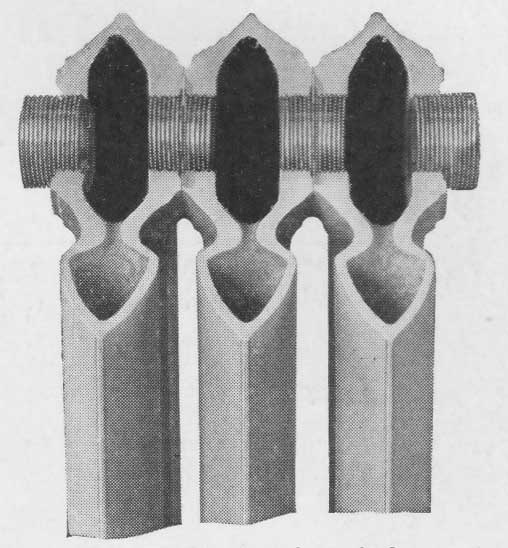
2. Pipes that connect to the radiator. Hot water radiators are always equipped with two pipes. Both of these pipes are usually, but not always, connected to the radiator at the bottom—one for hot water to enter the radiator and the other for draining out the cooled water.
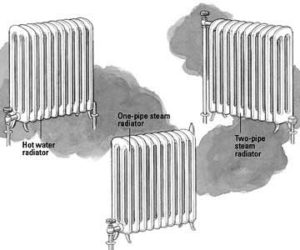 Steam radiators can have either one or two connections: hot steam enters on one side and condensed water can leave either through the same pipe or through a pipe on the other side. If there are two pipes, one is commonly towards the top and the other at the bottom.
Steam radiators can have either one or two connections: hot steam enters on one side and condensed water can leave either through the same pipe or through a pipe on the other side. If there are two pipes, one is commonly towards the top and the other at the bottom.
3. Temperature when in use. A steam-filled radiator becomes very hot; whereas a hot water radiator becomes warm, but not hot enough to burn at the touch.
4. Air valves and vents. A hot water radiator has an air valve towards the top of one side.
A steam radiator with one pipe will have an air vent on the side opposite the pipe, two-thirds of the way up between the top and bottom of the radiator. Steam rises and enters through the single pipe, pushing air out of the radiator through its vent. Condensed steam returns to the boiler through the same pipe, passing out through a special passage in the radiator control valve.
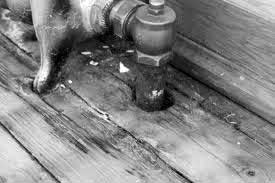 5. Operational noises. As stated earlier, steam radiators sometimes can be noisy.
5. Operational noises. As stated earlier, steam radiators sometimes can be noisy.
6. Floor beneath the radiator. Often a wood floor beneath a steam radiator will be warped due to damage from the steam and cause the radiator to be out of level on the floor.
How to Take Care of Your Radiators
Periodic maintenance of your radiators will help them work properly. And there are a few repairs you may decide to tackle.
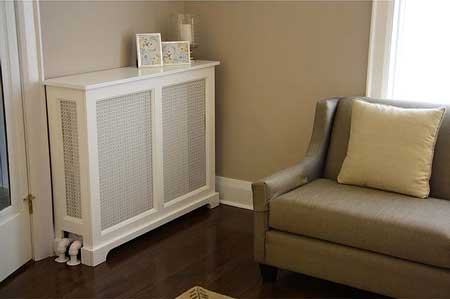 But first, a few decorating tips. Heated air must flow freely around each radiator. Decorative covers used to enclose a radiator should have plenty of openings. Never install heavy curtains or draperies in front of a radiator, and try to leave a space of several inches between the radiator and any large piece of furniture in front of it, especially pieces that go right down to the floor.
But first, a few decorating tips. Heated air must flow freely around each radiator. Decorative covers used to enclose a radiator should have plenty of openings. Never install heavy curtains or draperies in front of a radiator, and try to leave a space of several inches between the radiator and any large piece of furniture in front of it, especially pieces that go right down to the floor.
To increase the heating efficiency of a radiator, make a heat reflector to put behind it by taping heavy-duty aluminum foil to cardboard with the shiny side facing out. The radiant heat waves will bounce off the foil into the room instead of being absorbed by the wall behind the radiator.
 Hot water radiators need bleeding. “Bleeding” is the process of opening an air vent to allow the trapped air to escape so the flow of water can continue. Hot water radiators should be bled at least once each year, usually at the start of the heating season.
Hot water radiators need bleeding. “Bleeding” is the process of opening an air vent to allow the trapped air to escape so the flow of water can continue. Hot water radiators should be bled at least once each year, usually at the start of the heating season.
Steam radiators do not require bleeding. They have automatic air vents designed to permit air to escape by itself from the radiator as steam enters.
Radiators should be cleaned annually. Accumulated layers of dust will not only keep air from flowing freely but will also act as insulation that will slow the transmission of heat.
With steam heat, it is important that the radiators be level. If one of your radiators is not heating evenly, check whether the floor has settled beneath it. Adding shims beneath the radiator will bring it back into alignment.
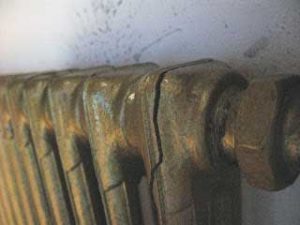 Leakage, while infrequent, can happen either around the supply valve or by a loose pipe connection. For the former, a flexible packing compound around the valve stem may need to be replaced. For a pipe leak, try tightening the connection with a wrench.
Leakage, while infrequent, can happen either around the supply valve or by a loose pipe connection. For the former, a flexible packing compound around the valve stem may need to be replaced. For a pipe leak, try tightening the connection with a wrench.
It is very uncommon for a crack to develop. This can happen when water is left inside and freezes in an unused radiator. You will need to replace the radiator.
Shopping for Radiators
Bauer Brothers Salvage in Minneapolis is a good place locally to start shopping for replacement radiators. You will see ornately decorated radiators in many sizes and shapes as well as utilitarian styles. Radiators are usually priced per section, taking into account the amount of decoration and any unique shape.
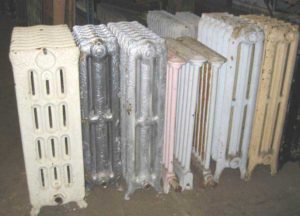 Salvage shops are also a good place to look for parts such as radiator controls, valves, and knobs for the valves. Do check the basements of other salvage and antiques shops—you may find the perfect radiator tucked in a corner somewhere.
Salvage shops are also a good place to look for parts such as radiator controls, valves, and knobs for the valves. Do check the basements of other salvage and antiques shops—you may find the perfect radiator tucked in a corner somewhere.
Two-pipe radiators are the most desirable because they can be converted for use with either a hot water or steam boiler.
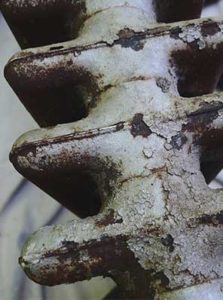 Many old radiators are covered with lead-based paint. If the paint is in bad shape or the color is not to your liking, you can strip the paint yourself (taking precautions against the lead) or hire a professional to sandblast the paint. It is important to apply an oil-based primer quickly so the cast iron does not rust. Historically, aluminum or bronze paints (in which the pigment consists of small flakes of metal) were used to give a metallic appearance.
Many old radiators are covered with lead-based paint. If the paint is in bad shape or the color is not to your liking, you can strip the paint yourself (taking precautions against the lead) or hire a professional to sandblast the paint. It is important to apply an oil-based primer quickly so the cast iron does not rust. Historically, aluminum or bronze paints (in which the pigment consists of small flakes of metal) were used to give a metallic appearance.
These cast iron radiators have been warming homes and commercial buildings for more than a hundred years. Get to know the heating system you have in your home to maintain your home comfortably. Do a little reading. Hopefully you will discover that searching for parts or the right radiator are well worth the time and trouble.
Resources
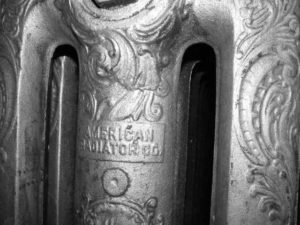 Bauer Brothers Salvage Inc.
Bauer Brothers Salvage Inc.
2432 Second Street N., Minneapolis
612-521-9492
www.bauerbrotherssalvage.com
Printed materials and web-based information to help you understand and maintain your home’s heating system are readily available. Examples are:
Books
- Anything written by Dan Holohan (google his name). Some titles are:
- The Lost Art of Steam Heating. 2002.
- Greening Steam. 2010.
- Classic Hydronics – How to Get the Most From Those Older Hot-Water Heating Systems. 2011.
 The Ideal Fitter, American Radiator Company. Published well into the 1930s, look for copies on Ebay or antique and salvage shops.
The Ideal Fitter, American Radiator Company. Published well into the 1930s, look for copies on Ebay or antique and salvage shops.
Websites
-
Old House Journal
www.oldhousejournal.com
Search “Dan Holohan” -
The New York Times
www.nytimes.com
Search “radiators”
Web Articles
-
“Boiler Systems and Radiators May Be Best Heating Choice”
HGTV
http://tinyurl.com/marx86t -
“Gravity Hot-Water Heating”
The Old House Web
http://tinyurl.com/nd5azkr -
“How to Take Care of Your Radiator”
Old House Online
http://tinyurl.com/pfdkx7m -
“Refinishing a Radiator”
U.S. General Services Administration
Historic Preservation – Technical Procedures
http://tinyurl.com/mzzsmh9 -
“Repairing Old Radiators”
Better Homes and Gardens
http://tinyurl.com/kfgebl5
Special thanks to Bungalow Club member Bill Blood (“This Old Handyman”) for contributing to this article; and to Dave Fridlund, Truth in Housing inspector, for content review.











